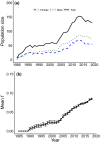Multiple life-stage inbreeding depression impacts demography and extinction risk in an extinct-in-the-wild species
- PMID: 33436770
- PMCID: PMC7804286
- DOI: 10.1038/s41598-020-79979-4
Multiple life-stage inbreeding depression impacts demography and extinction risk in an extinct-in-the-wild species
Abstract
Inbreeding can depress individuals' fitness traits and reduce population viability. However, studies that directly translate inbreeding depression on fitness traits into consequences for population viability, and further, into consequences for management choices, are lacking. Here, we estimated impacts of inbreeding depression (B, lethal equivalents) across life-history stages for an extinct-in-the-wild species, the sihek (Guam kingfisher, Todiramphus cinnamominus). We then projected population growth under different management alternatives with our B estimates incorporated, as well as without inbreeding depression (B = 0) or with a conventional default B. We found that inbreeding depression severely impacted multiple life-history stages, and directly translated into an effect on population viability under management alternatives. Simulations including our B estimates indicated rapid population decline, whereas projections without inbreeding depression or with default B suggested very gradual population decline. Further, our results demonstrate that incorporation of B across life-history stages can influence management decisions, as projections with our B estimates suggested a need to switch to increased breeding management to avoid species extinction and support wild releases. Our results demonstrate that magnitude of B across life-history stages can translate into demographic consequences, such that incorporation of multiple life-stage B into population models can be important for informed conservation management decision-making.
Conflict of interest statement
The authors declare no competing interests.
Figures



Similar articles
-
Using long-term data for a reintroduced population to empirically estimate future consequences of inbreeding.Conserv Biol. 2021 Jun;35(3):859-869. doi: 10.1111/cobi.13646. Epub 2021 Jan 21. Conserv Biol. 2021. PMID: 32997349
-
Inbreeding depression accumulation across life-history stages of the endangered Takahe.Conserv Biol. 2010 Dec;24(6):1617-25. doi: 10.1111/j.1523-1739.2010.01549.x. Conserv Biol. 2010. PMID: 20586788
-
Evidence of the phenotypic expression of a lethal recessive allele under inbreeding in a wild population of conservation concern.J Anim Ecol. 2016 Jul;85(4):879-91. doi: 10.1111/1365-2656.12503. Epub 2016 Mar 21. J Anim Ecol. 2016. PMID: 26996516
-
Inbreeding and Outbreeding Depression in Wild and Captive Insect Populations.Annu Rev Entomol. 2025 Jan;70(1):271-292. doi: 10.1146/annurev-ento-022924-020221. Annu Rev Entomol. 2025. PMID: 39874143 Review.
-
Understanding Inbreeding Depression, Purging, and Genetic Rescue.Trends Ecol Evol. 2016 Dec;31(12):940-952. doi: 10.1016/j.tree.2016.09.005. Epub 2016 Oct 12. Trends Ecol Evol. 2016. PMID: 27743611 Review.
Cited by
-
Genetic diversity in global populations of the critically endangered addax (Addax nasomaculatus) and its implications for conservation.Evol Appl. 2022 Dec 21;16(1):111-125. doi: 10.1111/eva.13515. eCollection 2023 Jan. Evol Appl. 2022. PMID: 36699120 Free PMC article.
-
Predation thresholds for reintroduction of native avifauna following suppression of invasive Brown Treesnakes on Guam.Ecol Appl. 2022 Dec;32(8):e2716. doi: 10.1002/eap.2716. Epub 2022 Sep 30. Ecol Appl. 2022. PMID: 36178004 Free PMC article.
-
Parallels and discrepancies between non-native species introductions and human migration.Biol Rev Camb Philos Soc. 2025 Jun;100(3):1365-1395. doi: 10.1111/brv.70004. Epub 2025 Feb 20. Biol Rev Camb Philos Soc. 2025. PMID: 39980263 Free PMC article. Review.
-
The genetic status and rescue measure for a geographically isolated population of Amur tigers.Sci Rep. 2024 Apr 6;14(1):8088. doi: 10.1038/s41598-024-58746-9. Sci Rep. 2024. PMID: 38582794 Free PMC article.
-
Estimation of Inbreeding Depression From Overdominant Loci Using Molecular Markers.Evol Appl. 2025 Mar 13;18(3):e70085. doi: 10.1111/eva.70085. eCollection 2025 Mar. Evol Appl. 2025. PMID: 40094104 Free PMC article.
References
-
- Keller LF, Waller DM. Inbreeding effects in wild populations. Trends Ecol. Evol. 2002;17:230–241. doi: 10.1016/S0169-5347(02)02489-8. - DOI
-
- Saccheri I, Kuussaari M, Kankare M, Vikman P, Hanski I. Inbreeding and extinction in a butterfly metapopulation. Nature. 1998;392:491–494. doi: 10.1038/33136. - DOI
Publication types
MeSH terms
LinkOut - more resources
Full Text Sources
Other Literature Sources

